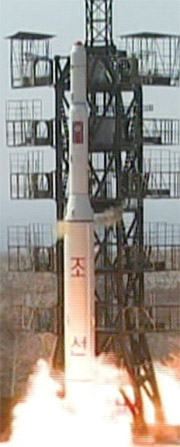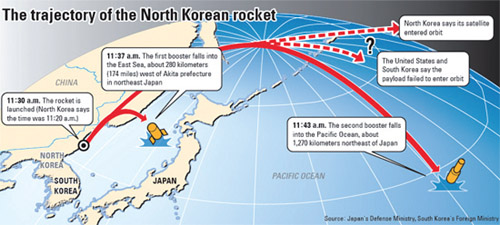Pyongyang launches long-range rocket

North Korea’s state-run TV released on April 7 a video clip showing the launch of a long-range rocket on April 5 from Musudan-ri, North Hamgyong Province. [AP] 북한 국영 조선중앙TV는 함경북도 무수단리에서 4월5일 발사한 장거리 로켓의 동영상을 4월7일 공개했다. [AP]
JoongAng Daily 1면 기사 Monday, April 6, 2009
Despite international calls against the move, North Korea yesterday launched a long-range rocket. But where it went is in dispute.
*in dispute : 논쟁중인, 미해결의
국제사회의 반대에도 불구하고 북한이 어제 장거리 로켓을 발사했다. 그러나 로켓의 행방에 대해서는 논란이 있다.
North Korea argued the rocket successfully put a satellite into orbit, but the U.S. military said the “missile” payload dropped into the Pacific Ocean. South Korea said the North appeared to have tried to launch a satellite but that it needed more time to determine the payload’s nature.
*satellite : (인공)위성
*payload : 탑재물체
북한은 로켓이 성공적으로 인공위성을 궤도에 진입시켰다고 주장하지만, 미 군사당국은 ‘미사일’ 탑재물체가 태평양으로 떨어졌다고 말했다. 남한은 북한이 인공위성을 쏘아 올리려고 시도했던 것처럼 보이지만 탑재물체의 정체를 확인하려면 좀 더 시간이 필요하다고 말했다.
The launch promptly drew strong criticism from South Korea and other nations. At Japan’s request, the United Nations Security Council was scheduled to have an emergency meeting behind closed doors at 4 a.m. this morning, Korean time, to discuss the launch.
*United Nations Security Council : 유엔 안전보장이사회
*behind closed doors : 비공개로, 비밀리에
남한과 다른 국가들은 즉각적으로 로켓발사를 강력하게 비난했다. 일본의 요청으로 유엔 안전보장이사회는 로켓 발사에 대해 논의하기 위해 한국 시각으로 오늘 오전 4시에 비공개 비상회의를 소집했다.
The North had announced in March that it would launch a satellite “for peaceful purposes” between April 4 and 8. North Korea said that its communications satellite, Kwangmyongsong-2, successfully entered orbit. But the U.S. and the South’s military disputed the claim.
*enter orbit : 궤도에 진입하다
*dispute : 이의를 제기하다, 논박하다, 다투다
북한은 4월4일과 8일 사이에 ‘평화적인 목적’으로 인공위성을 쏘아 올리겠다고 지난 3월에 발표했었다. 북한은 통신위성 광명성2호가 성공적으로 궤도에 진입했다고 발표했다. 그러나 미국과 남한의 군사당국은 그 주장을 반박했다.
In a statement, the North American Aerospace Defense Command and U.S. Northern Command said, “Stage one of the missile fell into the Sea of Japan [East Sea]. The remaining stages along with the payload itself landed in the Pacific Ocean. No object entered orbit.” Also, Lee Sang-hee, South Korea’s defense minister, told a parliamentary hearing that he estimated all stages of the rocket had fallen into water and “we believe no object entered orbit.”
*North American Aerospace Defense Command : 북미 항공우주 방위 사령부
북미 항공우주 방위 사령부와 미군 북부 사령부는 “미사일 1단계 추진체는 동해로 떨어졌다. 나머지 단계 추진체들은 탑재물체와 함께 태평양에 떨어졌다. 어떤 물체도 궤도에 진입하지 않았다.”고 성명을 통해 밝혔다. 남한의 이상희 국방장관도 국회 답변에서 로켓의 모든 단계의 추진체들이 바다로 떨어진 것으로 추정하며 “어떤 물체도 궤도에 진입하지 않았다고 판단한다”고 말했다.
The North’s state-run Korean Central News Agency reported that the launch took place at 11:20 a.m. from its base in Musudan-ri, northeast of the peninsula, and that the satellite entered orbit at 11:29 a.m. South Korea said earlier that the launch occurred at 11:30 a.m. The South Korean government was trying to determine the cause of the time difference.

북한의 국영 조선중앙통신은 로켓은 오전 11시20분 한반도 북동쪽 무수단리 기지에서 발사됐으며 인공위성은 11시29분에 궤도에 진입했다고 보도했다. 이 보도에 앞서 남한은 발사는 11시30분에 이뤄졌다고 발표했다. 남한 정부는 발사 시간 차이의 원인에 대해 조사 중이다.
번역 : 이무영 정치사회팀장 (mooyoung@joongang.co.kr)










with the Korea JoongAng Daily
To write comments, please log in to one of the accounts.
Standards Board Policy (0/250자)